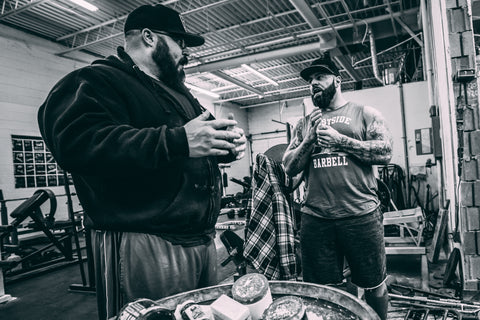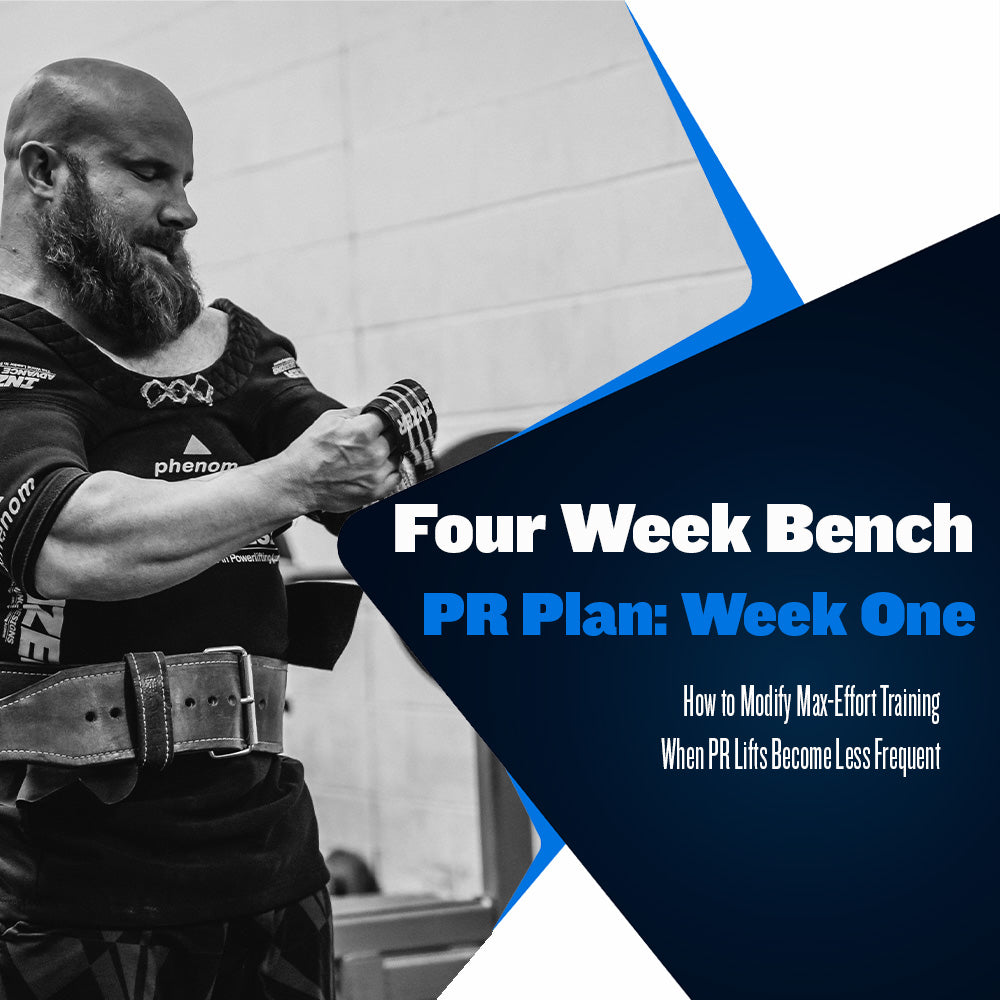Four Weeks to a Bench PR: Week One

The Conjugate system includes weekly max-effort exercises performed with the intent to lift the heaviest weight we can on that specific day for that particular exercise. Often, this max lift will be a newly established PR lift. However, that is not always the case. As you accumulate training time, you may reach a point you cannot consistently hit a PR lift when you train a max-effort exercise.
Fortunately, this is not that big of an issue. The intention of max-effort training is to lift the heaviest weight possible, with the goal being to recruit the greatest number of motor units possible. By achieving maximal motor unit recruitment, we can improve absolute strength, eventually leading to a new PR lift being established.
So, if you are amidst a PR drought, do not let that discourage you or make you lose faith in your approach. One way to ensure that you are still on track strength-wise is to pay attention to your dynamic effort training. As long as you are still moving your dynamic effort weights with authority and you can recover from session to session, it is unlikely you are overly fatigued or overtrained.
It may be a matter of needing to adjust your approach to provide some unfamiliar or modified stimulus so you can establish a new PR lift. Over the next four weeks, I will explain how we alter our max-effort training when PR lifts have decreased in frequency.
Main Exercise
For week one, we will perform a close-grip bench press for a top set of 5 reps. You may be saying to yourself, “that’s not in the realm of true max-effort training,” and you would be correct to some degree. However, training in intensity ranges of 80-85% for a multi-rep top set will allow an athlete to recruit enough motor units on the final rep to provide still beneficial stimulus capable of influencing an increase in absolute strength.
This main exercise should be relatively easy if you have been performing weeks and weeks of authentic max-effort training. A top set of 5 will be demanding but less demanding than an all-out max single. With less fatigue being accrued during the main exercise, the athlete will have an opportunity to get a bit of a leg up as far as recovery goes.
This is why I choose to program a five-rep top set when transitioning to this programming style; it immediately puts some gas back in the tank.
Here is how a 500lb close-grip bencher would perform this exercise:
Set 1 - 135lbs x 10
Set 2 - 225lbs x 5
Set 3 - 275lbs x 5
Set 4 - 325lbs x 5
Set 5 - 365lbs x 1
Set 6 - 405lbs x 1
Set 7 - 425lbs x 5
As you can see, we begin with warm-up sets, starting with 135lbs for 10 to get loosened up, then moving into five rep warm-up sets up to 65%. At that point, we begin performing singles to ensure that we carry enough energy into the top set of the day, considering our primary goal is to lift 85% for five reps. We warm up to set ourselves up for the best top set; we don’t warm up to tire ourselves out for the top set.
Accessory Exercises
The accessory work for this week will include an overhead press variation for the primary accessory exercise. With the intensity of the main exercise being low compared to the typical max-effort training day, throwing in another multi-joint exercise trained at a moderate-high intensity will provide additional benefits leading to gains in strength.
The remaining exercises will focus on addressing weaknesses and building muscle mass. For this series of articles, we will say the athlete’s weakness is the triceps. Here is how we would go about programming the first week of accessory exercises:
Exercise 1 - Push Press - work up to a top set of 5
Exercise 2 - Rolling DB Tricep Extensions - 4 x 12-15
Exercise 3 - Chest-Supported Rows - 4 x 8-10
Exercise 4 - Tricep Cable Pressdowns - 3 x 15
Exercise 5 - Hammer Curls - 5 x 10
Exercise 6 - Standing Lateral Raises - 3 x 15
Exercise 7 - Tricep Band Pressdowns - 3 x AMRAP
Although this may seem like a lot of volume, consider that the athlete will not be training in typical max effort intensity ranges (1-3 reps, 90%+). After the main exercise, you will likely have plenty of energy to work through and recover from this amount of accessory volume with no issues.
Additionally, the top set of five reps on the push press will be limited by the fatigue carried over from the main exercise, so in reality, it won’t be a true five-rep max. However, it will provide a beneficial stimulus that will help improve the strength of the shoulders, triceps, upper back, and trunk.
Adapt or Die
We want to stick to the typical execution of the methods as much as possible. However, there will eventually come a time when things become stagnant in your training cycle. You may feel like you’re excessively fatigued or reach a point where PR lifts become difficult to muster. At these points in training, athletes must make simple adjustments to remain capable of achieving their training goals.
Understanding the feedback and data training provides, along with knowing when to alter the approach, is critical to an athlete's success. No strategy works all of the time, so it is vital to have a plan in place so you can quickly switch gears and get back on track.
Over the next four weeks, you will see how we go about doing this at Westside Barbell. Ideally, you will remember these articles and return to them when you find yourself in a PR slump. Remember, as long as you can adapt and program according to the feedback your training provides; you will always be able to improve.
Read The Whole Series
Four Weeks to a Bench PR: Week One (You are Here)
Four Weeks to a Bench PR: Week Two
Four Weeks to a Bench PR: Week Three
Four Weeks to a Bench PR: Week Four
Where To Learn More
For a more in-depth look at bench pressing, including effective training methods, technique, and even more sample workouts, check out our Bench Press Manual here.
The Bench Press Manual by Louie Simmons is a comprehensive guide to mastering the bench press and achieving pers... The Bench Press Manual by Louie Simmons is a comprehensive guide to mastering the bench press and achieving pers...
$20
${ productPrice }
${ originalPriceWithQuantity }
${ productPrice }
$20
${ productPrice }
${ originalPriceWithQuantity }
${ productPrice }
Sources:
Simmons, L. (2007). Westside Barbell Book of Methods. Westside Barbell.
Verkhoshansky, Y., & Siff, M. C. (2009). Supertraining. Verkhoshansky.





